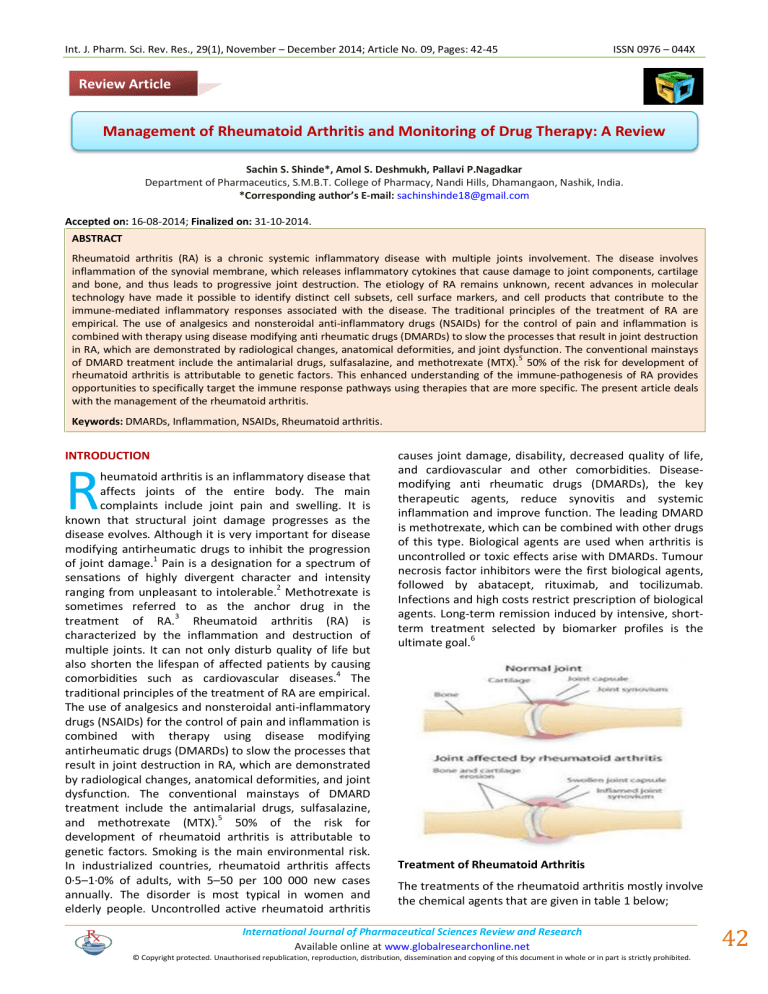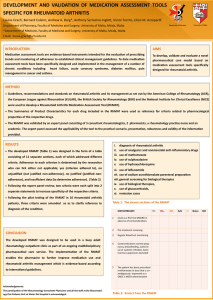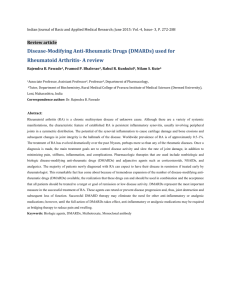Document 13310070

Int. J. Pharm. Sci. Rev. Res., 29(1), November – December 2014; Article No. 09, Pages: 42-45 ISSN 0976 – 044X
Review Article
Management of Rheumatoid Arthritis and Monitoring of Drug Therapy: A Review
Sachin S. Shinde*, Amol S. Deshmukh, Pallavi P.Nagadkar
Department of Pharmaceutics, S.M.B.T. College of Pharmacy, Nandi Hills, Dhamangaon, Nashik, India.
*Corresponding author’s E-mail: sachinshinde18@gmail.com
Accepted on: 16-08-2014; Finalized on: 31-10-2014.
ABSTRACT
Rheumatoid arthritis (RA) is a chronic systemic inflammatory disease with multiple joints involvement. The disease involves inflammation of the synovial membrane, which releases inflammatory cytokines that cause damage to joint components, cartilage and bone, and thus leads to progressive joint destruction. The etiology of RA remains unknown, recent advances in molecular technology have made it possible to identify distinct cell subsets, cell surface markers, and cell products that contribute to the immune-mediated inflammatory responses associated with the disease. The traditional principles of the treatment of RA are empirical. The use of analgesics and nonsteroidal anti-inflammatory drugs (NSAIDs) for the control of pain and inflammation is combined with therapy using disease modifying anti rheumatic drugs (DMARDs) to slow the processes that result in joint destruction in RA, which are demonstrated by radiological changes, anatomical deformities, and joint dysfunction. The conventional mainstays of DMARD treatment include the antimalarial drugs, sulfasalazine, and methotrexate (MTX).
5
50% of the risk for development of rheumatoid arthritis is attributable to genetic factors. This enhanced understanding of the immune-pathogenesis of RA provides opportunities to specifically target the immune response pathways using therapies that are more specific. The present article deals with the management of the rheumatoid arthritis.
Keywords: DMARDs, Inflammation, NSAIDs, Rheumatoid arthritis.
INTRODUCTION
R heumatoid arthritis is an inflammatory disease that affects joints of the entire body. The main complaints include joint pain and swelling. It is known that structural joint damage progresses as the disease evolves. Although it is very important for disease modifying antirheumatic drugs to inhibit the progression of joint damage.
1
Pain is a designation for a spectrum of sensations of highly divergent character and intensity ranging from unpleasant to intolerable.
2
Methotrexate is sometimes referred to as the anchor drug in the treatment of RA.
3
Rheumatoid arthritis (RA) is characterized by the inflammation and destruction of multiple joints. It can not only disturb quality of life but also shorten the lifespan of affected patients by causing comorbidities such as cardiovascular diseases.
4
The traditional principles of the treatment of RA are empirical.
The use of analgesics and nonsteroidal anti-inflammatory drugs (NSAIDs) for the control of pain and inflammation is combined with therapy using disease modifying antirheumatic drugs (DMARDs) to slow the processes that result in joint destruction in RA, which are demonstrated by radiological changes, anatomical deformities, and joint dysfunction. The conventional mainstays of DMARD treatment include the antimalarial drugs, sulfasalazine, and methotrexate (MTX).
5
50% of the risk for development of rheumatoid arthritis is attributable to genetic factors. Smoking is the main environmental risk.
In industrialized countries, rheumatoid arthritis affects
0·5–1·0% of adults, with 5–50 per 100 000 new cases annually. The disorder is most typical in women and elderly people. Uncontrolled active rheumatoid arthritis causes joint damage, disability, decreased quality of life, and cardiovascular and other comorbidities. Diseasemodifying anti rheumatic drugs (DMARDs), the key therapeutic agents, reduce synovitis and systemic inflammation and improve function. The leading DMARD is methotrexate, which can be combined with other drugs of this type. Biological agents are used when arthritis is uncontrolled or toxic effects arise with DMARDs. Tumour necrosis factor inhibitors were the first biological agents, followed by abatacept, rituximab, and tocilizumab.
Infections and high costs restrict prescription of biological agents. Long-term remission induced by intensive, shortterm treatment selected by biomarker profiles is the ultimate goal.
6
Treatment of Rheumatoid Arthritis
The treatments of the rheumatoid arthritis mostly involve the chemical agents that are given in table 1 below;
International Journal of Pharmaceutical Sciences Review and Research
Available online at www.globalresearchonline.net
© Copyright protected. Unauthorised republication, reproduction, distribution, dissemination and copying of this document in whole or in part is strictly prohibited.
42
© Copyright protected. Unauthorised republication, reproduction, distribution,
Int. J. Pharm. Sci. Rev. Res., 29(1), November – December 2014; Article No. 09, Pages: 42-45 ISSN 0976 – 044X
Table 1: The various agents used for the treatment of RA
S. No. Agents used for the treatment of Rhumatoid Arthritis
1 Non-steroidal anti-inflammatory drugs (NSAIDs)
2
3
4
Disease-modifying antirheumatic drugs (DMARDs)
Corticosteroids
Biological response modifiers. hydroxychloroquine termed triple therapy. Use of
DMARD combinations varies across different countries; in some regions they are used rarely. Adverse effects of
DMARDs include those that are minor (eg, nausea) and serious (eg, hepatotoxicity, blood dyscrasias, and interstitial lung disease).
12-13
Monitoring of adverse effects requires pretreatment screening and subsequent safety recording of blood counts and liver function tests.
14
Non-Steroidal Anti-Inflammatory Drugs
NSAIDs are an integral part of the management of RA.
However, they are ‘adjuncts to’ and not ‘substitutes for’
DMARDs. Both agents are started together. DMARDs take several weeks to act and during this time NSAIDs are invaluable in reducing pain and inflammation. Once the disease has been brought into clinical quiescence by the use of DMARDs, NSAIDs can be stopped altogether or used intermittently on an ‘as needed’ basis, while
DMARDs are continued long term. NSAIDs are also useful in treating rheumatoid flares. Various NSAIDs, in equivalent doses, do not differ in efficacy; only the sideeffects may differ. The use of a particular agent is more a matter of choice and patient tolerance than anything else. Combining two or more NSAIDs is counterproductive since this increases the incidence of side-effects without increasing efficacy. The major adverse effects of NSAIDs are gastrointestinal (GI) and renal toxicity. GI injury is due to topical irritant actions that disrupt the epithelial barrier, as well as the inhibition of cyclo-oxygenase (COX), predominantly the COX-1 iso form in the mucosa.
cause GI side-effects irrespective of the route of administration (oral, parenteral or rectal). This is because the side-effects are mainly due to prostaglandin inhibition and not so much due to the topical effects. Selective COX-
2 inhibitors such as celecoxib, rofecoxib, valdecoxib and etoricoxib have a lesser propensity to cause GI sideeffects. They are cost-effective in patients who are at high risk for GI events such as elderly patients with cardiopulmonary disease or patients on concomitant steroids. However, they are as likely to cause renal injury as conventional NSAIDs.
2,8
Disease-Modifying Anti rheumatic Drugs
7
NSAIDs
DMARDs can be instituted in various ways as shown in table 2.
Table 2: Approaches for DMRDs.
Approach
Step-up approach
Step-down approach
Saw-tooth approach
Parallel approach
Corticosteroids
15
Description
Therapy is started with a single
DMARD, other agents are added one by one till response is achieved.
Several DMARDs are started together till remission; one agent is then continued and others withdrawn.
Therapy is started with a single
DMARD which is substituted by another agent in case of toxicity or when it ceases to be effective—‘slipout’.
Several DMARDs are started simultaneously and continued.
Corticosteroids, both systemic and intra-articular, are important adjuncts in the management of RA. They effectively relieve synovitis. Low doses of glucocorticoid substantially retard the rate of joint destruction as seen on X-rays and have a disease modifying potential.
However, they are double-edged weapons. The serious adverse effects such as weight gain, hypertension, osteoporosis, cataract, hyperglycaemia, accelerated atherosclerosis, etc. preclude their use as diseasemodifying agents in RA. Though long term, low dose glucocorticoid therapy probably increases the risk of serious adverse effects, an evidence-based case can be made for the limited use of low dose glucocorticoid treatment in early disease. The indications for systemic corticosteroids in RA may be summarized as follows:
Disease-modifying anti rheumatic drugs (DMARDs) are a heterogeneous collection of agents grouped together by use and convention. They are the mainstay of treatment for rheumatoid arthritis.
9
Their diverse mechanisms of action are incompletely understood. They reduce joint swelling and pain, decrease acute-phase markers, limit progressive joint damage, and improve function.
Methotrexate is the dominant DMARD. Sulfasalazine and leflunomide are also widely used. Their efficacy has been established in placebo-controlled trials.
10
Hydroxychloroquine and chloroquine have DMARD-like properties. Gold (rINN sodium aurothiomalate) and ciclosporin are additional DMARDs; their use is limited by toxic effects. DMARDs are sometimes combined, and several combinations of DMARDs have proven efficacy.
11
An example is methotrexate, sulfasalazine, and
1.
2.
3.
4.
5.
as ‘bridge therapy’ for 8–12 weeks before the onset of action of DMARDs; for the treatment of rheumatoid flares; for extra-articular RA such as rheumatoid vasculitis and interstitial lung disease; maintenance doses <10 mg of prednisolone daily in patients where RA is active despite NSAIDs and
DMARDs; and in pregnancy when other DMARDs cannot be used.
Intra-articular corticosteroids are used to manage one or more ‘recalcitrant’ joints that continue to show active clinical synovitis in spite of systemic therapy. Joint
International Journal of Pharmaceutical Sciences Review and Research
Available online at www.globalresearchonline.net
© Copyright protected. Unauthorised republication, reproduction, distribution, dissemination and copying of this document in whole or in part is strictly prohibited.
43
© Copyright protected. Unauthorised republication, reproduction, distribution,
Int. J. Pharm. Sci. Rev. Res., 29(1), November – December 2014; Article No. 09, Pages: 42-45 ISSN 0976 – 044X infection should always be ruled out before local steroid injections are given.
15-16
Biological Response Modifiers
Biological response modifiers (BRMs) refer to genetically engineered treatments such as monoclonal antibodies and receptor– immunoglobulin fusion proteins. These are designed to modulate a specific aspect of the underlying autoimmune process while avoiding generalized immune suppression. The need for BRMs has arisen because conventional DMARDs have several shortcomings such as slow onset of action, partial remission in many cases, substantial toxicity that requires careful monitoring, and tendency to lose effectiveness with time—‘slip-out’.
Better understanding of the pathogenesis of RA has enabled the development of interventions that integrate molecular biology with bedside medicine. The biological therapies in vaccine), etc. Currently, the major thrust is on cytokine antagonists, especially tumor necrosis factor (TNF)-a antagonists.
17
RA include cytokine antagonists, costimulation blockers, anti-B cell therapies (rituximab), oral tolerance therapy, rheumatoid vaccine (TCR peptide
Table 3: Approaches for DMRDs.
15
Future Perspectives: Pain is a designation for a spectrum of sensations of highly divergent character and intensity ranging from unpleasant to intolerable. Although many unresolved difficulties exist for people with rheumatoid arthritis, continuing introduction of innovative treatments can overcome many of them. One key need is definition of disease subsets in individuals with early arthritis so that intensive treatment regimens can be targeted at patients who most need them and are likely to respond.
We also need to move beyond long term suppressive treatment towards short intensive therapeutic courses that result in remission. This progression requires improved drugs and biomarkers that accurately predict patients’ status, using pathological information.
2,13-15
CONCLUSION
Rheumatoid arthritis (RA) is characterized by the inflammation and destruction of multiple joints. The various methods or agents for the treatment of rheumatoid arthritis are used that are shortly described in this review.
REFERENCES
1.
Kou Katayama, Takeo Matsuno, Long-term efficacy of leflunomide on disease activity and inhibition of joint damage: retrospective comparison with methotrexate for
Japanese rheumatoid arthritis patients, Mod Rheumatol,
19, 2009, 513-521.
International Journal of Pharmaceutical Sciences Review and Research
Available online at www.globalresearchonline.net
© Copyright protected. Unauthorised republication, reproduction, distribution, dissemination and copying of this document in whole or in part is strictly prohibited.
44
© Copyright protected. Unauthorised republication, reproduction, distribution,
Int. J. Pharm. Sci. Rev. Res., 29(1), November – December 2014; Article No. 09, Pages: 42-45 ISSN 0976 – 044X
2.
Amol S. Deshmukh, Pravin G. Morankar, Manoj R.
Kumbhare, Review on Analgesic Activity and Determination
7.
Methods, Pharmtechmedica, 3(1), 2014, 425-428.
3.
American college of rheumatology subcommittee on rheumatoid arthritis guidelines, Guidelines for the management of rheumatoid arthritis, Arthritis Rheum, 46,
2002, 328-346.
4.
Nobuyuki Miyasaka, Treatment trends of rheumatoid arthritis in Japan: Changes toward globalization and its unique innovation. Inflammation and Regeneration, 31(1),
2011, 25-32.
5.
Han-Ming Lai, Chung-Jen Chen, Biologics in the treatment of rheumatoid arthritis: recent advances, Formosan Journal of Rheumatology, 22, 2008, 12-24.
6.
Storey GO, Comer M, Scott DL, Chronic arthritis before
1876: early British cases suggesting rheumatoid arthritis,
Ann Rheum Dis, 53, 1994, 557–560.
Whittle BJ, Gastrointestinal effects of nonsteroidal antiinflammatory drugs, Fundam Clin Pharmacol, 17, 2003,
301–313.
8.
Gambaro G, Perazella MA, Adverse renal effects of antiinflammatory agents: Evaluation of selective and nonselective cyclooxygenase inhibitors, J Intern Med, 253,
2003, 643–652.
9.
Donahue KE, Gartlehner G, Jonas DE, et al., Systematic review: comparative effectiveness and harms of diseasemodifying medications for rheumatoid arthritis, Ann Intern
Med, 148, 2008, 124–134.
10.
Osiri M, Shea B, Robinson V, et al., Leflunomide for the treatment of rheumatoid arthritis: A systematic review and meta analysis, J Rheumatol, 30, 2003, 1182–1190.
11.
Choy EH, Smith C, Doré CJ, Scott DL, A meta-analysis of the efficacy and toxicity of combining disease-modifying antirheumatic drugs in rheumatoid arthritis based on patient withdrawal, Rheumatology (Oxford), 44, 2005, 1414–1421.
12.
Salliot C, van der Heijde D, Long-term safety of methotrexate monotherapy in patients with rheumatoid arthritis: a systematic literature research, Ann Rheum Dis,
68, 2009, 1100–1104.
13.
Alcorn N, Saunders S, Madhok R, Benefi t-risk assessment of leflunomide: an appraisal of leflunomide in rheumatoid arthritis 10 years after licensing, Drug Saf, 32, 2009, 1123–
1134.
14.
Chakravarty K, McDonald H, Pullar T, et al, On behalf of the
British Society for Rheumatology, British Health
Professionals in Rheumatology Standards, Guidelines and
Audit Working Group, in consultation with the British
Association of Dermatologists (BAD). BSR/BHPR guideline for disease-modifying anti-rheumatic drug (DMARD) therapy in consultation with the British Association of
Dermatologists. Rheumatology (Oxford), 47, 2008, 924–
925.
15.
R. Handa, Management of rheumatoid arthritis, The
National Medical Journal of India, 17, 2004, 143-151.
16.
Handa R, Interventional rheumatology: An emerging new concept, J Assoc Physicians India, 52, 2004, 275–277.
17.
Handa R, Immuno interventions in rheumatoid arthritis, J
Indian Rheum Assoc, 4, 1996, 134–145.
Source of Support: Nil, Conflict of Interest: None.
International Journal of Pharmaceutical Sciences Review and Research
Available online at www.globalresearchonline.net
© Copyright protected. Unauthorised republication, reproduction, distribution, dissemination and copying of this document in whole or in part is strictly prohibited.
45
© Copyright protected. Unauthorised republication, reproduction, distribution,








